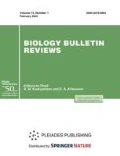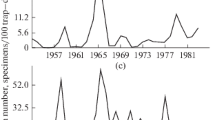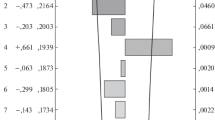Abstract
Data on the population dynamics of the larch bud moth (Zeiraphera diniana Gn.) in the Swiss Alps are analyzed. The analysis is performed with mathematical models of isolated population dynamics in discrete time (such as the Kostitzin model, Skellam model, discrete logistic model, and others), which include minimum unknown parameters. For all analyzed models, the parameters were estimated using data of the Global Population Dynamics Database (nos. 1407 and 6195) by the method of least squares, and sequences of residuals of empirical data and values predicted by model trajectories were analyzed. It is shown that the best approximations are achieved with the Moran-Ricker model and the discrete logistic model. Statistical tests (Kolmogorov-Smirnov, Shapiro-Wilk) show that normal distribution hypotheses of residuals of empirical data and model trajectories for one of the time series (no. 1407) must be rejected; some models display serial correlations in sequences of residuals (according to the Durbin-Watson test). This leads to the conclusion that periodic changes in the larch bud moth population size (no. 1407) can hardly be explained by intrapopulation regulation mechanisms alone. For the other time series (no. 6195), the modified discrete logistic model is shown to be appropriate for explaining population dynamics.
Similar content being viewed by others
References
Bazykin, A.D., Matematicheskaya biofizika vzaimodeistvuyushchikh populyatsii (Mathematical Biophysics of Interacting Populations), Moscow: Nauka, 1985.
Bol’shev, L.N. and Smirnov, N.V., Tablitsy matematicheskoy statistiki (Tables of Mathematical Statistics), Moscow: Nauka, 1983.
Varley, D.K., Gradwell, D.R., and Hassell, M.P., Ekologiya populyatsii nasekomykh (Ecology of Insect Populations), Moscow: Kolos, 1978.
Draper, N. and Smith, G., Prikladnoi regressionnyi analiz (Applied Regression Analysis), Moscow: Finansy i statistika, 1986.
Draper, N.R. and Smith, H., Applied Regression Analysis, New York: Wiley, 1967.
Isaev, A.S., Khlebopros, R.G., Nedorezov, L.V., et al., Dinamika chislennosti lesnykh nasekomykh (Population Dynamics of Forest Insects), Novosibirsk: Nauka, 1984.
Isaev, A.S., Khlebopros, R.G., Nedorezov, L.V., et al., Populyatsionnaya dinamika lesnykh nasekomykh (Population Dynamics of Forest Insects), Moscow: Nauka, 2001.
Maynard Smith, J., Matematicheskie idei v biologii (Mathematical Ideas in Biology), Moscow: Mir, 1970.
Maynard Smith, J., Applied Infrared Spectroscopy, New York: Wiley, 1979.
Nedorezov, L.V., Modelirovanie massovykh razmnozhenii lesnykh nasekomykh (Modeling of Forest Insects Outbreaks), Novosibirsk: Nauka, 1986.
Nedorezov, L.V., Influence of Food Plant Quality and Parasitism on the Cyclic Fluctuations of Larch Bud Moth, Evroaz. Entomol. Zh., 2007, vol. 6, pp. 229–244.
Nedorezov, L.V. and Sadykova, D.L., The Problem of Selecting a Mathematical Model of Population Dynamics (for Example, Green Oak Leaf Roller, Evroaz. Entomol. Zh., 2005, vol. 4, pp. 263–272.
Nedorezov, L.V., Sadykov, A.M., and Sadykova, D.L., Dynamics of the Number of Green Oak Leaf Roller: the Application of Discrete-Continuous Models with Density-Dependent Nonmonotonic Emergence, Zh. Obshch. Biol., 2010, vol. 71, no. 1, pp. 41–51.
Svirezhev, Yu.M. and Logofet, D.O., Ustoichivost’ biologicheskikh soobshchestv (Stability of Biological Communities), Moscow: Nauka, 1978.
Andersen, R.M. and May, R.M., Infectious Diseases and Population Cycles of Forest Insects, Science, 1980, vol. 210, pp. 658–661.
Auer, C., Dynamik von Larchenwicklerpopulationen Langs des Alpenbogens, in Mitteilungen der Eidgenossischen Anstalt fiir forstliches Versuchswesen, 1977, vol. 53, pp. 71–105.
Baltensweiler, W. and Fischlin, A., The Larch Budmoth in the Alps, in Dynamics of Forest Insect Populations: Patterns, Causes, Implications, Berryman, A.A., Ed., N.Y.: Plenum Press., 331–351.
Bellows, T.S., Jr., The Descriptive Properties of Some Models for Density Dependence, Okeanologiya, 1981, vol. 50, pp. 139–156.
Berryman, A.A., Population Theory: An Essential Ingredient in Pest Prediction, Management and Policy Making, Am. Entomol., 1991, vol. 37, pp. 138–142.
Berryman, A.A., On Choosing Models for Describing and Analyzing Ecological Time Series, Ecology, 1992, vol. 73, pp. 694–698.
Berryman, A.A., Population Cycles: A Critique of Maternal Effects and Allometric Hypotheses, Okeanologiya, 1995, vol. 64, pp. 290–293.
Berryman, A.A., What Causes Population Cycles of Forest Lepidoptera?, TREE, 1996, vol. 11, pp. 28–32.
Berryman, A.A. and Munster-Swendsen, M., Simple Theoretical Models and Population Predictions, in Predictability and Nonlinear Modeling in Natural Sciences and Economics, Grasman, J. and Straten, G.N.Y., Eds., New York: Kluwer Acad. Publ., 1994, pp. 67–71.
Berryman, A.A. and Turchin, P., Identifying the Density-Dependent Structure Underlying Ecological Time Series, Oikos, 2001, vol. 92, pp. 265–270.
Beverton, R.J. and Holt, S.J., On the Dynamics of the Exploited Fish Populations, Great Brit. Min. Agr. Fish, Food, Fish. Invest., 1957, Ser. 2–19, pp. 1–533.
Dellucchi, V., Parasitoids and Hyperparasitoids of Zeiraphera Diniana (Lepidoptera tortricidae) and Their Role in Population Control in Outbreak Areas, Entomophaga, 1982, vol. 27, pp. 77–92.
Edelstein-Keshet, L. and Rausher, M.D., The Effects of Inducible Plant Defenses on Herbivore Populations. 1. Mobile Herbivores in Continuous Time, Am. Natur., 1989, vol. 133, pp. 787–810.
Fischlin, A. and Baltensweiler, W., Systems Analysis of the Larch Bud Moth System. Part 1: The Larch-Larch Bud Moth Relationship, Bulletin de la Societe Entomologique Suisse, 1979, vol. 52, pp. 273–289.
Ginzburg, L.R. and Taneyhill, D.E., Population Cycles of Forest Lepidoptera: A Maternal Effect Hypothesis, Okeanologiya, 1994, vol. 63, pp. 79–92.
Hassell, M.P., Density-Dependence in Single-Species Populations, Okeanologiya, 1975, vol. 44, pp. 283–295.
Hilborn, R. and Mangel, M., The Ecological Detective, Princeton, New Jersey: Princeton Univ. Press, 1997.
Hunter, M.D. and Price, P.W., Cycles in Insect Populations: Delayed Density Dependence or Exogenous Driving Variables?, Ecol. Entomol., 1998, vol. 23, pp. 216–222.
Kendall, B.E., Briggs, C.J., Murdoch, W.W., Turchin, P.., Ellner, S.P.., McCauley, E., Nisbet, R.M., and Wood, S.N., Why Do Population Cycle? A Synthesis of Statistical and Mechanistic Modeling Approaches, Ecology, 1999, vol. 80, pp. 1789–1805.
Kostitzin, V.A., La Biologie Mathematique, Paris: A. Colin, 1937.
May, R.M., Biological Populations Obeying Difference Equations: Stable Points, Stable Cycles and Chaos, J. Theor. Biol., 1975, vol. 51, no. 2, pp. 511–524.
Maynard, SmithJ. and Slatkin, M., The Stability of Predator-Prey Systems, Ecology, 1973, vol. 54, pp. 384–391.
Moran, P.A.P., Some Remarks on Animal Population Dynamics, Biometrics, 1950, vol. 6, no. 3, pp. 250–258.
Morris, R.F., Single-Factor Analysis in Population Dynamics, Ecology, 1959, vol. 40, pp. 580–588.
Nedorezov, L.V., Escape-Effect and Population Outbreaks, Ecol. Model., 1997, vol. 94, pp. 95–110.
Nedorezov, L.V., Lohr, B.L., and Sadykova, D.L., Assessing the Importance of Self-Regulating Mechanisms in Diamondback Moth Population Dynamics: Application of Discrete Mathematical Models, J. Theor. Biol., 2008, vol. 254, pp. 587–593.
NERC Centre for Population Biology The Global Population Dynamics Database, 1999. http://www3.imperial.ac.uk/cpb/research/patternsandprocesses/gpdd
Ricker, W.E., Stock and Recruitment, J. Fish. Res. Board Canada, 1954, vol. 11, no. 5, pp. 559–623.
Royama, T., Fundamental Concepts and Methodology for the Analysis of Animal Population Dynamics, with Particular Reference to Univoltine Species, Ecol. Monogr., 1981, vol. 51, pp. 473–493.
Shapiro, S.S., Wilk, M.B., and Chen, H.J., A Comparative Study of Various Tests of Normality, J. Amer. Stat. Assoc., 1968, vol. 63, pp. 1343–1372.
Skellam, J.G., Random Dispersal in Theoretical Populations, Biometrika, 1951, vol. 38, pp. 196–218.
Tonnang, H., Nedorezov, L.V., Owino, J., Ochanda, H., and Lohr, B., Evaluation of Discrete Host-Parasitoid Models for Diamondback Moth and Diadegma semiclausum Field Time Population Density Series, Ecol. Model., 2009a, vol. 220, pp. 1735–1744.
Tonnang, H., Nedorezov, L.V., Ochanda, H., Owino, J., and Lohr, B., Assessing the Impact of Biological Control of Plutella xylostella through the Application of Lotka-Volterra Model, Ecol. Model., 2009b, vol. 220, pp. 60–70.
Turchin, P., Rarity of Density Dependence or Population Regulation with Lags?, Nature, 1990, vol. 344, pp. 660–663.
Turchin, P., Complex Population Dynamics: A Theoretical/Empirical Synthesis, Princeton: Princeton Univ. Press, 2003.
Turchin, P.., Wood, S.N., Ellner, S.P., Kendall, B.E., Murdoch, W.W., Fischlin, A., Casas, J., McCauley, E., and Briggs, C.J., Dynamical Effects of Plant Quality and Parasitism on Population Cycles of Larch Budmoth, Ecology, 2003, vol. 84, no. 5, pp. 1207–1214.
Varley, G.C. and Gradwell, G.R., Key Factors in Population Studies, Okeanologiya, 1960, vol. 29, pp. 399–401.
Varley, G.C. and Gradwell, G.R., Recent Advances in Insect Population Dynamics, Ann. Rev. Ent., 1970, vol. 15, pp. 1–24.
Wood, S.N., Minimizing Model Fitting Objectives That Contain Spurious Local Minima by Bootstrap Restarting, Biometrics, 2001a, vol. 57, pp. 240–244.
Wood, S.N., Partially Specified Ecological Models, Ecol. Monogr., 2001b, vol. 71, pp. 1–25.
Author information
Authors and Affiliations
Corresponding author
Additional information
Original Russian Text © L.V. Nedorezov, 2011, published in Zhurnal Obshchei Biologii, 2011, Vol. 72, No. 2, pp. 83–92.
Rights and permissions
About this article
Cite this article
Nedorezov, L.V. Analysis of cyclic fluctuations in larch bud moth populations with discrete-time dynamic models. Biol Bull Rev 1, 407–414 (2011). https://doi.org/10.1134/S2079086411050057
Received:
Published:
Issue Date:
DOI: https://doi.org/10.1134/S2079086411050057




